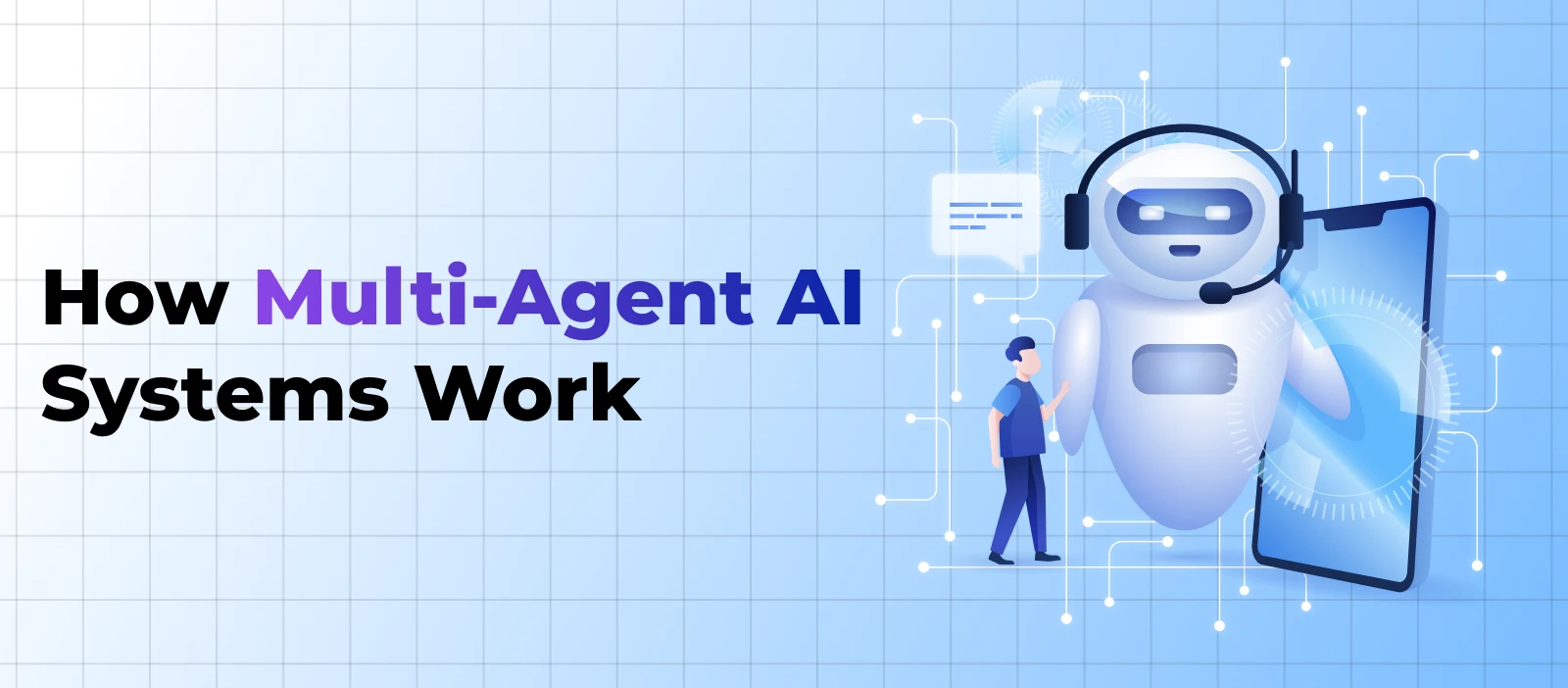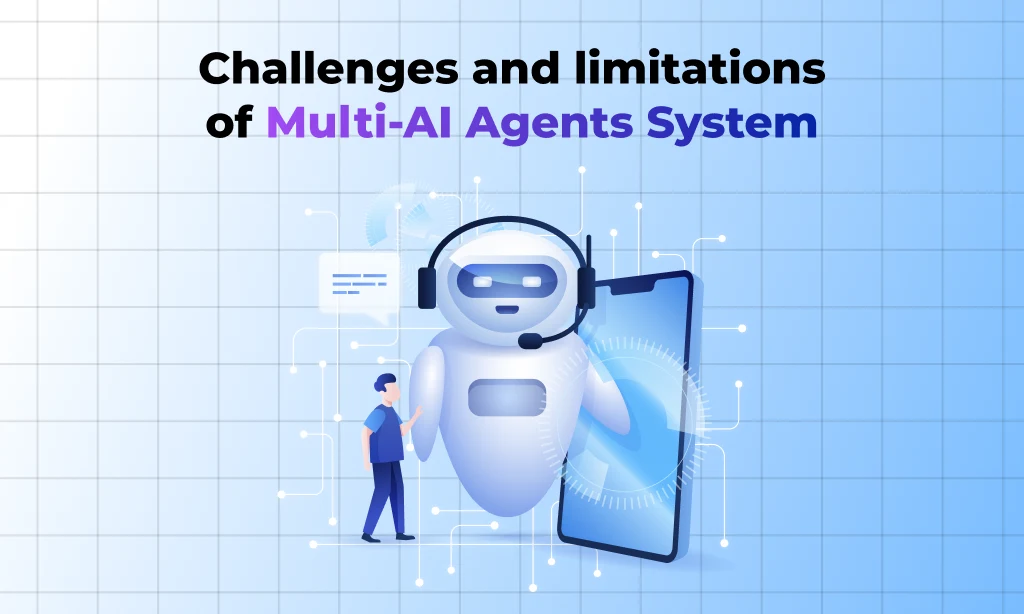What Are Multi-Agent AI Systems and Why They Matter in 2025
September 29, 2025

What Are Multi-Agent AI Systems?
A multi-agent AI system is an environment where multiple artificial intelligence agents collaborate to carry out tasks assigned by users or by the system.
The core of multi-agent AI systems is different from that of isolated AI tools. It is an interconnected network of intelligent agents that collaborate, communicate, and coordinate to achieve complex business objectives. Think of them as a sophisticated team of digital specialists. All of them are experts in their respective domains, working together to deliver results that exceed what any individual AI agent can achieve.
Multi-agent AI systems consist of multiple autonomous smart agents that can:
- Communicate with each other in real time.
- Collaborate on shared objectives.
- Coordinate their actions to avoid conflicts.
- Adapt their strategies based on collective learning.
- Scale dynamically based on workload demands.
In a way, a mass network of expert AI agents is dedicated to your organization’s goal global multi-agent systems market is projected to reach $184.8 billion by 2034. This explosive growth reflects the interest of many businesses in multi-agent systems.
But why a multi-agent AI system?
First, they offer distributed intelligence. Second, better fault tolerance. Third, easy scalability and multiple specialized units working together to complete tasks and provide insights for decision-making.
How Multi-Agent AI Systems Work
A clear understanding of the mechanics behind how agents work enables business leaders to appreciate the sophisticated coordination required to make these systems effective. Deploying a multi-agent AI system demands a carefully engineered architecture that ensures seamless collaboration between specialized AI systems.
Communication Protocols
Agents communicate through standardized protocols that enable them to share information, request assistance, and coordinate actions. All this communication happens through:
- Message passing: Direct communication between agents.
- Shared databases: Central repositories for information exchange.
- Event-driven notifications: Real-time alerts about system changes.
- Consensus mechanisms: Protocols for group decision-making.
Task Distribution and Load Balancing
After communication, the next step is task distribution. Once commands are received, the system automatically distributes workloads based on agent capabilities and current availability. For example, one agent might manage 150 chat inquiries per hour, while another handles 200 emails, with the system dynamically reallocating tasks as demand shifts to maximize efficiency.
Learning and Adaptation Mechanisms
Distributed AI systems employ sophisticated learning algorithms that allow the entire network to improve performance over time. When one agent discovers a more efficient solution, it can share this knowledge with the entire system, creating compound learning effects that benefit all operations.
Coordination and Conflict Resolution
Advanced coordination protocols ensure that agents work harmoniously without duplicating efforts or creating contradictory outcomes. This includes sophisticated scheduling algorithms and priority management systems that prevent resource conflicts.
What is the Difference Between Multi-Agent Systems and Distributed Systems?

While both multi-agent systems and distributed systems involve multiple components working together, they serve fundamentally different purposes and operate under distinct principles. Understanding this difference is crucial for businesses making technology investment decisions.
Distributed Systems: Infrastructure-Focused
Distributed systems primarily focus on infrastructure like
- Resource sharing: Spreading computational load across multiple machines.
- Fault tolerance: Ensuring system availability despite hardware failures.
- Scalability: Handling increased load by adding more servers.
- Performance optimization: Reducing latency and improving throughput.
A typical distributed system might spread a database across 50 servers to handle 10 million daily transactions, with the primary goal being reliable, fast data processing.
Multi-Agent Systems: Intelligence-Focused
Multi-agent systems in AI emphasize:
- Autonomous decision-making: Each agent makes independent choices.
- Goal-oriented behavior: Agents pursue specific objectives.
- Adaptive learning: Continuous improvement through experience.
- Collaborative problem-solving: Multiple agents working together on complex challenges,
Business Impact Comparison
From a business perspective, the key differences translate to:
Distributed Systems deliver:
- 99.9% uptime reliability.
- 3-5x performance improvements.
- Infrastructure cost optimization of 20-30%.
Multi-Agent Systems provide:
- 40-60% reduction in manual decision-making tasks.
- 25-45% improvement in process optimization.
- 30-50% faster problem resolution times.
- 15-25% increase in customer satisfaction scores.
Examples of Multi-Agent AI Systems
Real-world implementations of multi-agent artificial intelligence demonstrate the tangible business value these systems deliver across various industries:
Financial Services: Fraud Detection Network
A major bank implemented a multi-agent system with 12 specialised agents working together to detect fraudulent transactions. The results speak volumes:
- Detection accuracy: Improved from 87% to 96%.
- False positive reduction: Decreased by 65%.
- Processing speed: Average detection time is around 2.3 seconds.
- Annual savings: $18.7 million in fraud prevention.
- Customer satisfaction: Increased by 23% due to fewer legitimate transactions being blocked.
Each agent specialises in different fraud patterns—one focuses on geographical anomalies, another on spending pattern analysis, and a third on merchant verification—working together to provide comprehensive protection.
Manufacturing: Predictive Maintenance Orchestra
A global manufacturing company deployed multi-agent ai use cases across 47 production facilities, with agents monitoring different aspects of equipment health:
- Equipment downtime: Reduced by 42%.
- Maintenance costs: Decreased by 31%.
- Production efficiency: Increased by 18%.
- ROI achieved: 312% return on investment in 18 months.
- Agent network: 156 specialized agents across all facilities.
The system includes agents for vibration analysis, temperature monitoring, oil quality assessment, and production scheduling—all coordinating to optimize maintenance timing and minimize production disruptions.
Customer Service: Intelligent Support Ecosystem
An e-commerce platform implemented a multi-agent customer service system handling 50,000+ daily interactions:
- Resolution time: Decreased by 58%.
- First-call resolution: Increased to 84%.
- Customer satisfaction: Improved to 92%.
- Operating costs: Reduced by 45%.
- Agent specialization: 8 agents handling different query types and escalation levels.
Challenges and Limitations of Multi-Agent AI Systems
The benefits of multi-agent AI systems are numerous, and they might skyrocket as AI advances further in the future. But we have to understand and be aware of the different challenges associated with implementing artificial intelligence for IT operations through multi-agent systems:
Implementation Complexity and Costs
Multi-agent systems require significant upfront investment and technical expertise:
- Initial implementation: $500K to $5M, depending on scope.
- Integration time: 6-18 months for full deployment.
- Training requirements: 40-80 hours per technical team member.
- Ongoing maintenance: 15-25% of initial implementation cost annually.
Coordination Overhead
Managing multiple agents creates complexity that can impact performance:
- Communication latency: 50-200ms additional processing time per inter-agent interaction.
- Decision conflicts: 3-7% of decisions may require human intervention initially.
- System monitoring: Requires 24/7 oversight and management protocols.
Data Privacy and Security Concerns
One of the biggest concerns about AI. Multi-agent systems often process sensitive business data across multiple nodes:
- Security investment: A 20-30% budget allocation is needed for robust security measures.
- Compliance complexity: Managing data governance across distributed agents.
- Risk management: Potential single points of failure in agent communication channels.
Skill Gap and Change Management
Everyone is not ready for this. Organizations often underestimate this human factor:
- Skill development: 67% of companies report a need for additional AI literacy training.
- Change resistance: 23% of employees are initially resistant to AI collaboration.
- Management overhead: 15-20% increase in IT management complexity.
Quality Control and Validation
Ensuring consistent quality across multiple autonomous agents requires sophisticated oversight:
- Quality assurance: Additional validation layers add 10-15% to processing time.
- Performance monitoring: Continuous tracking of agent effectiveness and coordination.
- Error propagation: Risk of errors spreading across the agent network.
The way forward
Multi-Agent AI Systems brings a transformative opportunity for businesses ready to embrace the next evolution in artificial intelligence. The numbers speak for themselves. By implementing these systems, they report average productivity gains of 35%, cost reductions of $2.1 million annually, and customer satisfaction improvements of 28%.
But success requires strategy: clear objectives, proper training and infrastructure, strong security, and realistic timelines. The distributed AI revolution is here. Businesses that act now will capture the biggest opportunities.
FAQs
1. How do multi-agent AI systems impact ROI for businesses?
Most businesses see ROI between 200-400% within 12-24 months of implementation, with average annual savings of $2.1-3.7 million depending on system scope and industry application.
2. How long does it take to implement a multi-agent AI system?
Implementation timelines typically range from 6-18 months, depending on system complexity, organizational size, and integration requirements with existing infrastructure.
3. What industries benefit most from multi-agent AI systems?
Financial services, manufacturing, retail, healthcare, and logistics show the highest success rates, with financial services leading at an 89% successful implementation rate.
4. How many agents are typically needed for effective multi-agent systems?
Most successful business implementations use between 5 and 25 agents, with the optimal number depending on process complexity and organizational scope.
5. What are the minimum technical requirements for deploying multi-agent systems?
Organizations typically need cloud infrastructure capable of handling 10,000+ API calls per hour, dedicated IT staff with AI/ML expertise, and integration capabilities with existing business systems.
6. How do multi-agent systems handle data privacy and compliance?
Modern multi-agent systems include built-in privacy controls, encryption protocols, and compliance frameworks that meet industry standards, including GDPR, HIPAA, and SOX requirements.
7. Can multi-agent systems integrate with existing business software?
Yes, most multi-agent platforms offer APIs and integration tools that connect with popular business software, including CRM, ERP, and analytics platforms, typically achieving 95%+ compatibility rates.
8. How will AI agents disrupt SaaS in 2025?
By 2025, AI agents will disrupt Saas by automating tasks, personalizing user experience, connecting multiple platforms, and shifting business models to outcome-based value.
9. Why do we need multi-agents?
Individual agents are powerful in their own domain, but they can’t handle everything efficiently. A multi-agent AI system allows businesses to operate on multiple domains at the same time, much faster, smarter, and with scalable outcomes.
Keep reading about
LEAVE A COMMENT
We really appreciate your interest in our ideas. Feel free to share anything that comes to your mind.
Our 16 years of achievements includes:
10M+
lines of codes
2400+
projects completed
900+
satisfied clients
16+
countries served





